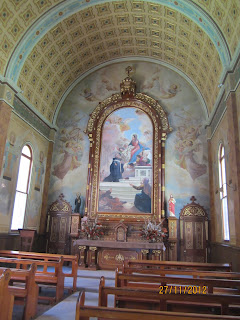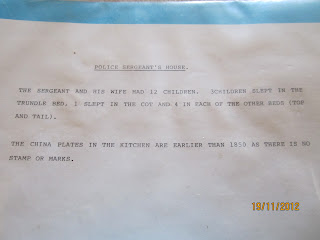 |
| The Gates to the monastery |
When I say ‘monastic’ town, it’s just that – everything is constructed, owned
and controlled by a small group of Benedictine monks.
Commenced in the mid 1800’s by two Spanish Benedictine monks, it is the
only town of its type in Australia. Originally a self-contained mission, it was
unusual in its day in that the monks paid the Aboriginal labourers for their
work in addition to providing housing, education and spiritual opportunities (also known as 'converting the natives to Christianity!). In the early 20th century, girls
and boys boarding schools were established (segregated into male/female and Aboriginal/European) and the town became renowned as an education
centre. Today, the schools have all
closed, and the town focuses on tourism and providing residential facilities
for retreats, school camps and accommodation for travellers.
Throughout all of these varying purposes, the one thing that has remained constant has been the monks daily routine, revolving around six defined group prayer sessions as well as daily mass. It looks like this:
 |
| The European boys school - St Ilifonses |
Throughout all of these varying purposes, the one thing that has remained constant has been the monks daily routine, revolving around six defined group prayer sessions as well as daily mass. It looks like this:
5.15am - Vigils
6.45am - Lauds
7.30am - Mass
12.05pm- Midday Prayer
2.30pm- Afternoon Prayer
6.30pm- Vespers
8.15 - Compline
The public are invited to attend any of the above and we went along to Vespers in the monastery chapel at 6.30pm one evening. Together with 4 other tourists, we waited (a bit nervously) in the chapel, not knowing what to expect.Right on 6.30pm, the 8 remaining monks (all elderly, apart from the head monk, known as the Abbot, who is about 50) entered the chapel.Four monks sit on either side of the chapel facing each other.The prayers were all sung, or chanted.One side (4 monks) would chant something and the 4 monks on the other side would respond. I say they were chanting ‘something’ as most of it was in Latin.They basically continued this for half an hour, then all faced the Alter, bowed, and silently left the room.I can’t begin to tell you how great the singing was - imagine what the sound must be like when the monks were at their maximum numbers of 70-80 monks.
Based on our Vespers experience, we thought it might be interesting to attend Mass with the monks the next day. As we have become very indulgent in the mornings with a lie in and at least two cups of tea in bed, I didn't old high hopes we'd actually follow through with our intention. However, we did get up early, it was even chilly and drizzly outside (the best lie in weather!) and made it to Mass - at 7.30am on a Thursday, and it wasn't even Christmas Day! I don’t think I’ve been to Mass on a weekday since I was at secondary school and we used to go the first Friday of every month. Again, it was just the four of us, one other parishioner, and the 8 monks and 1 nun. Again, they faced each other, but this time it was the familiar Catholic mass that I remembered, except most of it was sung. All over in 30 minutes, and then the monks filed out and it was all over. They walked single file over the road into the monastery courtyard and that was the last we saw of them. Not that I want to start attending Mass every morning, but it was a very calm way to start the day.
Originally, the monks were very hands-on in the fields, in their own flour mill, growing olives and tending orchids and teaching in the schools, but these days their focus is on theology study and the administration of the township. That’s when they aren’t praying of course!
The churches and chapels are full of wall-to-wall artwork similar to what Larry and I have seen in hundreds of churches in Europe (in fact, we saw so many churches, it’s been over 20 years before we could even contemplate appreciating the interior of a church – see the Geraldton blog entry!). All of the art work was completed by one of the monks with an artistic ability. Likewise, most of the fine timberwork and carving was also completed by a monk with exceptional woodturning skills.
The museum above the Visitors Centre is predominately full of traditional religious paintings similar to what we’ve seen in galleries in Europe and not something I thought we’d ever see in Australia. There are also some interesting and unusual modern religious art on display as well.
 |
| This piece of modern art, located just outside the Visitors Centre, seemed a bit incongruous with the surroundings. |
In addition to the art, St Joseph’s Aboriginal girls’ boarding school has a small exhibition showing what life was like in that institution. Basically it was all about a basic education and a lot of work –washing, mending, cleaning and cooking for the 400 inhabitants of the township. While these boarding schools would no doubt have been unduly strict by today’s standards, reading the reminisces of many past pupils, the kids seemed to have been well cared for in terms of food and shelter and seem to look back fondly on those years. Children were not removed from their parents to attend the school as most had parents who lived and worked in the township. I don’t doubt for a minute however, that many kids would have had a horrendous experience as well and I only hope the monks don’t get caught up into the upcoming royal commission into child abuse in institutions.
 |
| All four schools were next to each other yet totally isolated with these huge fences. |
 |
| Original timber shingles covered by corrugated iron! |
While there we visited the hotel
and sampled the Abbey Ale, at 7% alcohol, one was enough for me. The hotel,
built as a hostel for European parents visiting their children at the boarding
schools, is now a hotel and I couldn’t resist sneaking upstairs to check out
the huge staircase and wide verandas. It reminded me of the Raffles Hotel in
Singapore. New Norcia is full of grand buildings; it’s amazing what you could
do with cheap labour!
New Norcia also has its own bakery so we had bread both
days we were there. Of course, I couldn’t resist buying a couple of books about
the history of the town, which have since been successfully hidden from Larry
so I don't get the usual lecture about the weight of books yada yada......
Like Coober Pedy in SA, New Norcia
was totally unexpected. It literally felt like we’d boarded a plan and got off
in Spain. We loved the history, the story of its beginning, the buildings, but
above all, we loved the atmosphere. It was calm and peaceful. The religious
side of things was not overly obvious, yet it clearly permeates everything. The
staff speak softly, the notices for visitors were respectful, the cost to visit
is reasonable and we found ourselves just chilling out. It’s a place that will
stay with us for a long time. http://www.newnorcia.wa.edu.au/
 |
| It's Jacaranda season!! |











































